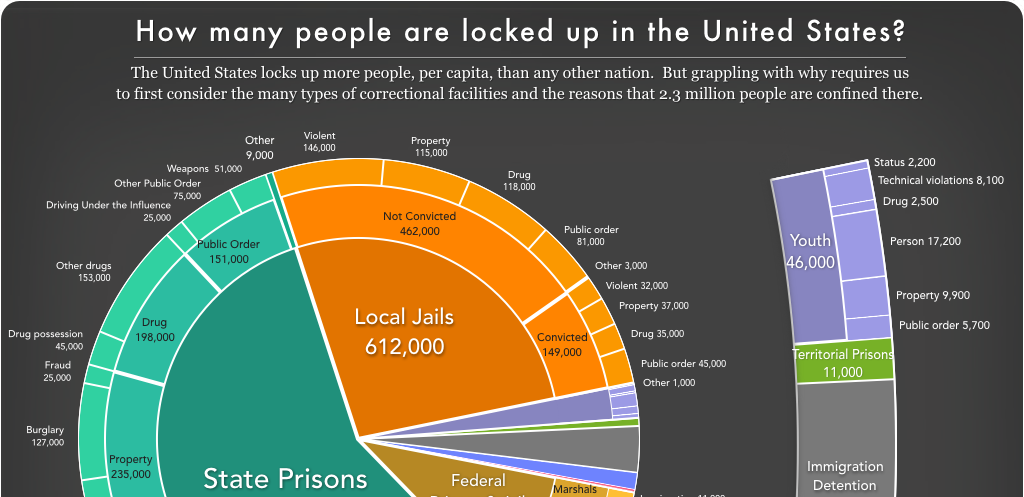New report, Mass Incarceration: The Whole Pie 2019, provides annual “big picture” view of confinement in the U.S. with 7 new infographics
With this year's updated edition of Mass Incarceration: The Whole Pie, we once again answer the essential questions of how many people are locked up, where, and why.
March 19, 2019
Easthampton, Mass. – Are there 1.3 million people incarcerated in the U.S., or is it actually closer to 2.3 million? Why – and where – are these millions of Americans behind bars? The country’s fragmented systems of confinement make answering basic questions about mass incarceration unnecessarily difficult. With this year’s updated edition of Mass Incarceration: The Whole Pie, we answer these essential questions with the most recent data, highlighting causes of incarceration that get too little attention as well as incarceration “myths” that receive too much.
The publication of the new report caps a year-long effort to update the public on the major drivers of incarceration – state prisons and local jails – as well as confined populations too often overlooked, such as people in post-release “civil commitment centers” and undocumented immigrants in detention.
“With such high public support for criminal justice reform, it’s urgent that we have a clear picture of who is locked up and where,” said author Wendy Sawyer. “For instance, many people don’t realize how much of mass incarceration is local. But one in four incarcerated people – and one in four ICE detainees – are held in local jails controlled by county sheriffs.”
The report’s other key findings include:
- 76% of people in local jails are not convicted of a crime, and many are there simply because they can’t afford money bail.
- 49,000 people are held by ICE for immigration offenses – a 43% increase since 2016. (This does not include the 11,800 immigrant children currently detained by the Office of Refugee Resettlement.)
- In a single year, 168,000 people were incarcerated for nothing more than a “technical violation” of probation or parole, such as a failed drug test.
- Contrary to a popular myth, only 7% of incarcerated people are held in privately-run facilities – but virtually all incarcerated people generate profit for private companies by paying for phone calls, medical care or other necessities.
The United States locks up more people than any other country, at a rate more than five times higher than most other nations. One impediment to reform is the lack of available data to guide that conversation. In Whole Pie, the Prison Policy Initiative provides the comprehensive view of mass incarceration that society needs in order to plot a path forward.
Mass Incarceration: The Whole Pie is one in a series of reports that provide equally comprehensive snapshots of women’s incarceration and youth confinement. Previous national reports from the Prison Policy Initiative include Following the Money of Mass Incarceration, which uses economic data to show who pays for and who benefits from mass incarceration, and Correctional Control, which breaks down the number of people in every state who are incarcerated, on probation, or on parole.
The non-profit, non-partisan Prison Policy Initiative was founded in 2001 to expose the broader harm of mass criminalization and spark advocacy campaigns to create a more just society. The organization leads the nation’s fight to keep the prison system from exerting undue influence on the political process (via prison gerrymandering) and plays a leading role in protecting the families of incarcerated people from the predatory prison and jail telephone industry and the video calling industry.
The full report and graphics are available at https://www.prisonpolicy.org/reports/pie2019.html




